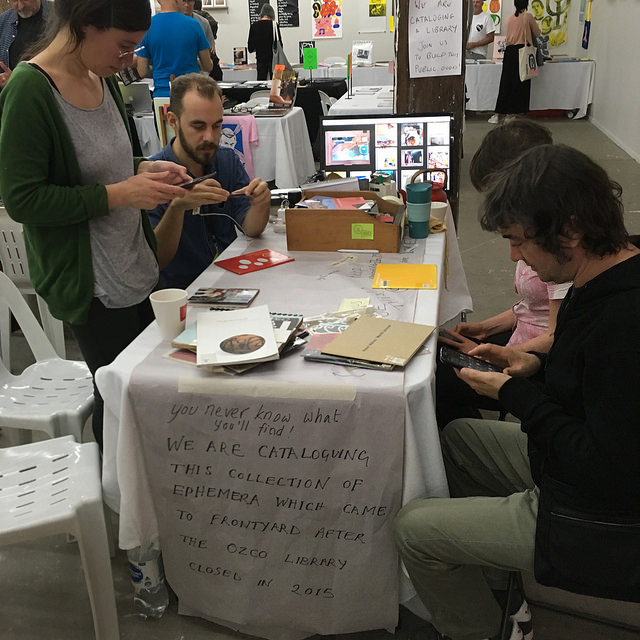
In mid-October 2017 some of the people who gather at Frontyard went on an off-yard excursion to maintain a ‘Frontyard table’ at VOLUME 2017: Another Art Book Fair at Art Space in Wolloomooloo, Sydney.
The VOLUME website describes the book fair:
The second edition of this biennial event features over 70 exhibitors from across Australia and the world, including Amsterdam, Hong Kong, South Korea, France and the United States. Alongside this international line up of publishers, artists, collectives, galleries and distributors is a free program of talks, artist-led workshops, book launches, readings and performances.
Our excursion was a successful because of the contribution of energy from the people who participated in its organisation and activities: Sophea, Sally, Julia, Pip, Benjamin, Mel, Nuno, Isabel, Pat, Clare, Miška, and me; all the Frontyard Janitors who quickly developed the idea of Frontyard’s involvement; Talia and the team from VOLUME who were extremely accomodating and supportive; and, the people presenting at and attending VOLUME who joined in.
I’ve made this post to document what we did and some of the decisions we made because the excursion went quite well; a record of we did might be useful in the future. The section on our setup and the timeline may be overly detailed for most readers.
Instigating off-yard activity
At the beginning of September 2017, Talia from VOLUME contacted Clare Cooper about Frontyard being involved in the public program of the fair, suggesting Frontyard run some kind presentation or workshop.
Clare forwarded the email on to the Frontyard janitors (aka board members; also, I’m one of them). Two janitors sent replies to Clare over the next week including this from Benjamin Forster:
perhaps it could be interesting to craft a conversation around provenience - https://medium.com/on-archivy/radtech-meets-radarch-towards-a-new-principle-for-archives-and-archival-description-568f133e4325 - given our ghost.
In the end no one replied to Talia. There was enthusiasm but no spare energy to catalyse a concrete plan and action to organise it. Talia emailed again in late September to remind us about the invitation, and an agenda item was added to the upcoming monthly Frontyard janitors meeting to discuss participating in VOLUME.
When thinking through how people who meet around Frontyard might be involved in any off-yard events we are invited to, we prioritise activities that will feed energy in rather than require a big expenditure that feeds some external beneficiary. Our tactics include bringing the event to Frontyard, and using the event to focus on something we’d like to do anyway.
One activity that people at Frontyard are trying to build energy for is cataloguing the Frontyard library’s ephemera collection.
The Frontyard library is our Australia Council for the Arts’ former research library which was decommissioned in 2014. It made its way here with custodian Benjamin Forster who co-founded Frontyard. It’s now installed in Marrickville at Frontyard and is accessible once again as a non-lending library that anyone can visit. Most of it is catalogued, but there are still about 900 ‘ephemera’ works in boxes to be added.
The janitors came up with the idea of taking these boxes and the existing task of cataloguing them to the VOLUME book fair so that our participation would produce something of benefit to the people who meet at Frontyard and to welcome new people to join us in the activity of building a shared public resource.
I emailed Talia back with our idea. Though it wasn’t what she had originally proposed, she supported us by making space for a Frontyard table at VOLUME.
The question of how to respond to these kinds of invitations has been a bit of a conundrum for the Frontyard janitors. Events are draining for people to plan, negotiate, and participate in. The compromises required to incorporate your creativity into someone else’s framework/context are often not worthwhile, and it can be hard to know if the host’s agenda will take priority over the participants and contributors until afterwards. In contrast, Frontyard aims to reduce the load on people who use it and let participants set the agenda.
With our response to VOLUME, we allowed the energy around a pre-existing activity at Frontyard to materialise a response and plan for participating in the off-yard event. It felt relaxed rather than pressured. The stakes were low: there was no risk of any energy being wasted by proposing something, because if things didn’t work out with VOLUME, we could proceed with the cataloguing at Frontyard. This won’t always be possible, and the event organisers wont always be so accommodating and in sync with our thinking, but it worked well in this case.
Preparing the cataloguing process
A few days after the janitors meeting, Pip, Ben, Sally, and I had a practice day to kick-off our cataloguing. We created a Google Form for capturing the information we wanted to note down about each ephemera work to be catalogued. For each work we wanted:
- the number of the box it came out of (1-6);
- its title;
- the URL for it in the Australian National Library’s Trove database (we can use this link to pull all kinds of useful information from their records later);
- a photo of its cover; and,
- if it isn’t represented in Trove: the author, publisher, year published, and language.
We found the cataloguing process quite smooth and generated interesting discussions and discoveries. We catalogued about 65 works on that test day.
I’ve found Google Forms to be really helpful it experimenting with data entry forms. The responses go to a spreadsheet you can work with, and you can also access a data feed of the entries via a public URL, if you open up the share settings (see my example of requesting and parsing that data feed).
At the book fair was an issue with the uploading stage of the Google Form regularly crashing the browser of the device the cataloguer was using. This was very frustrating as the cover photo capturing was at the end of the form and it would cause the person to loose their work for this item. As the form was quite short, this frustration wasn’t a blocker to people continuing to catalogue works. There may be a need to try a system that is less memory intensive on the devices in the future.
A day before the bookfair, Sophea, Pip, and I met at Frontyard to collect materials for the excursion: boxes, stationary, and a pot and cups for tea. Sophea created a roster that we used to ensure that we’d have a janitor or two at the table throughout the event. Sophea created it using a Google Spreadsheet and shared it through the Frontyard Slack Channel.
The Frontyard table
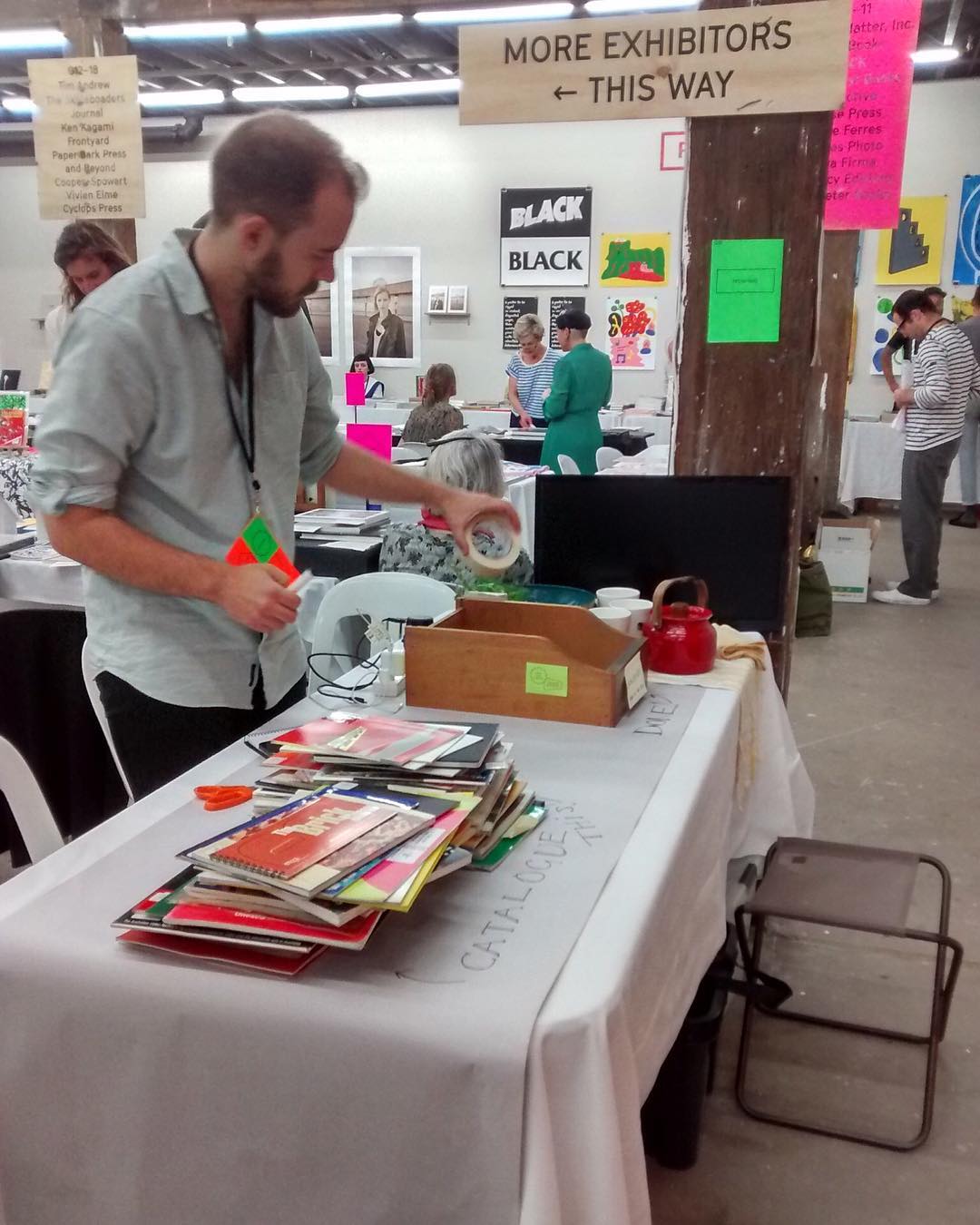
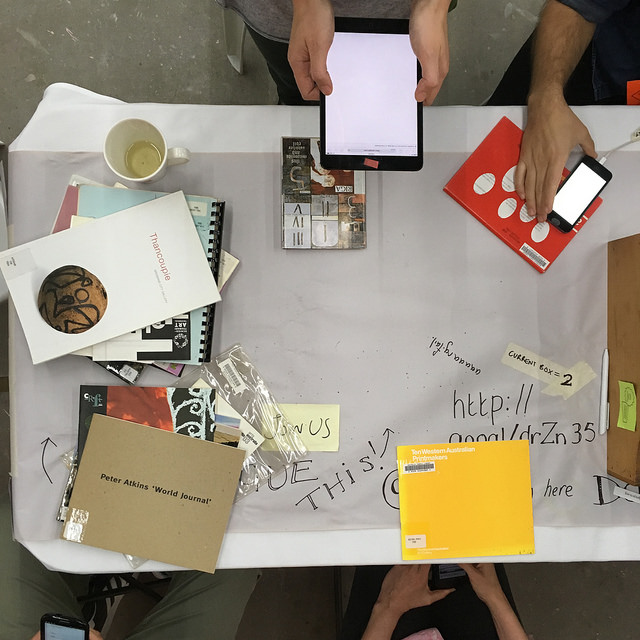
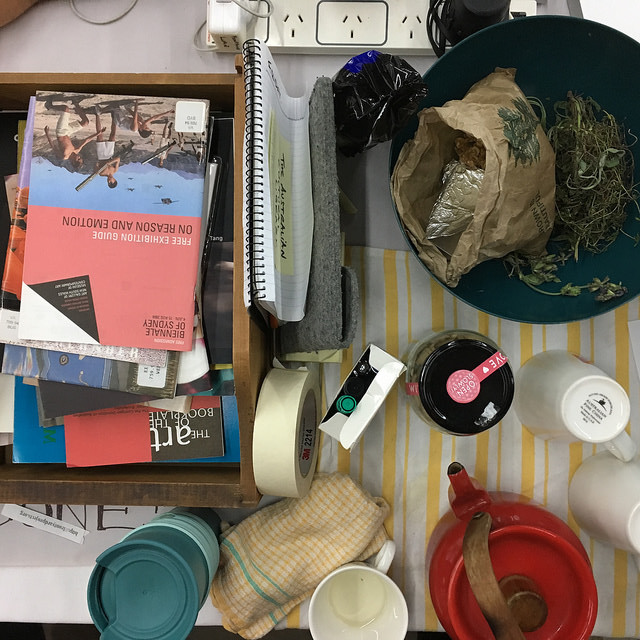
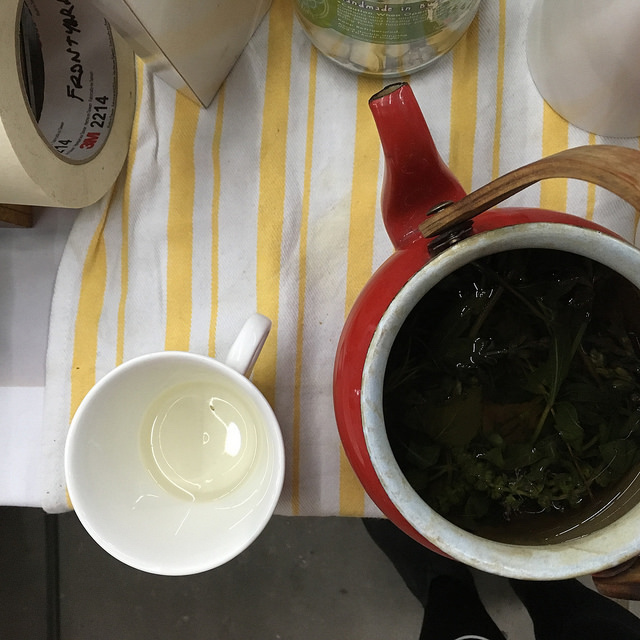
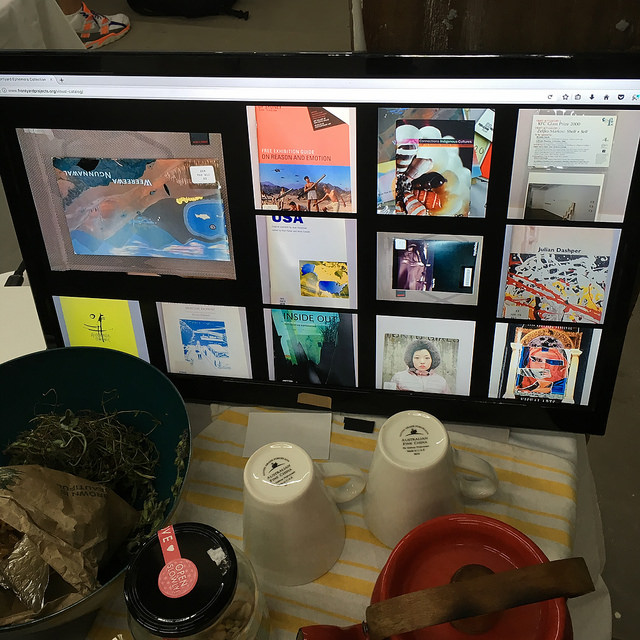
The fair was open 3pm-9pm Friday and 11am-6pm Saturday and Sunday. The Frontyard table was open and active throughout.
Frontyard’s table was just within the entrance to the eastern room at Art Space; left through the main entrance. It was a rectangular trestle table. The short-ends faced west towards the entrance and east towards the eastern wall of Art Space. The eastern edge sat flat against a wooden, structural column.
On the western end of Frontyard’s table, closest to the entrance, were a couple of piles of uncatalogued works from the Frontyard Library.
From the centre of the table to the eastern edge sat:
- a solid, wooden table draw, acting as a box, with a paper note labelling the contents “done”;
- a notebook, an iPad mini, and box of marker pens tucked behind the box;
- a red, metal teapot from the Frontyard kitchen;
- coffee cups from the Frontyard kitchen on a tea towel;
- a bowl of sage and thyme from the Frontyard garden and mint and fennel frons from the 107 Projects garden; and,
- a television monitor, lent against the wooden column, showing images of the most recent catalogued works taken by the cataloguers (images were loaded into a web page using a script hosted on GitHub Pages).
All these elements sat on top of butcher’s paper and a white table cloth which covered the table.
Along the south western edge of the table there was writing on the butcher’s paper: “CATALOGUE (verb) THIS! with us! @ online form here http://goo.gl/drZn35”, with an arrow pointing to the works to catalogue. Another arrow pointed from this instruction to the wooden box for catalogued works. These were the basic cataloguing instructions.
Under the table (from west to east) sat:
- two cardboard boxes of uncatalogued ephemera from the Frontyard library (boxes 1 and 2);
- a black plastic storage box with people’s bags, spare pens, tape for labeling everything, and other bits and pieces;
- a large, clear plastic storage box of works that had been catalogued (to keep the ‘done’ box from overflowing); and,
- a power board powering a laptop (Friday-Saturday afternoon) then a Mac Mini (Saturday afternoon-Sunday) which fed the display monitor on the table above.
Cataloguing at the book fair
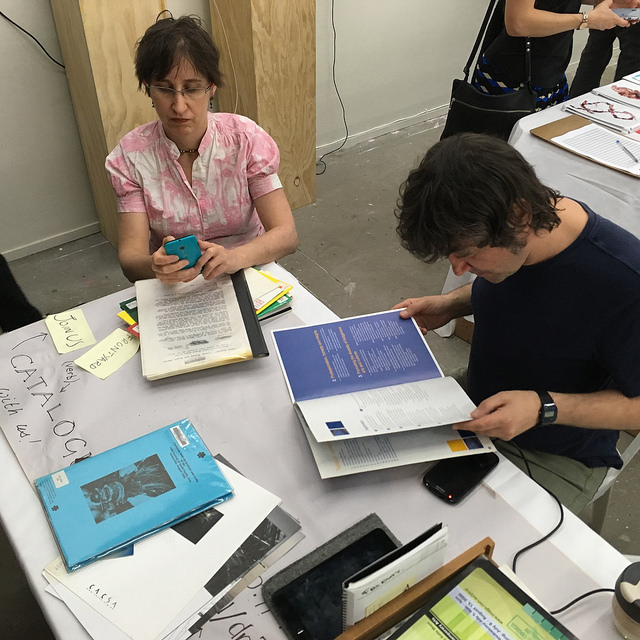
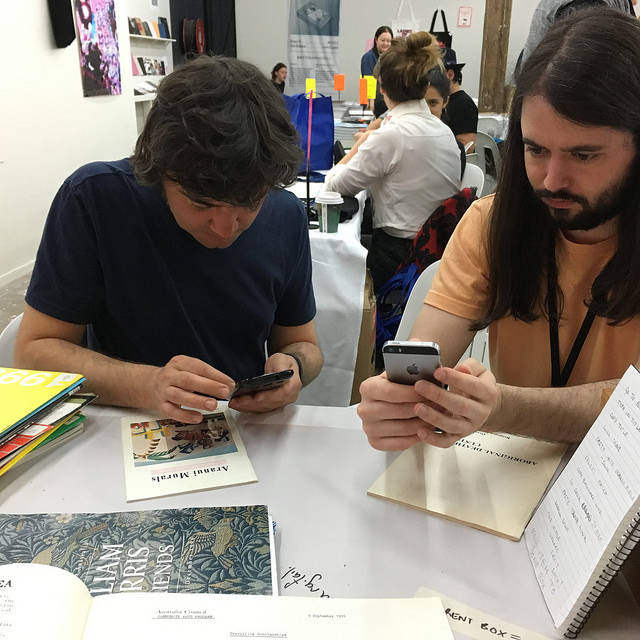
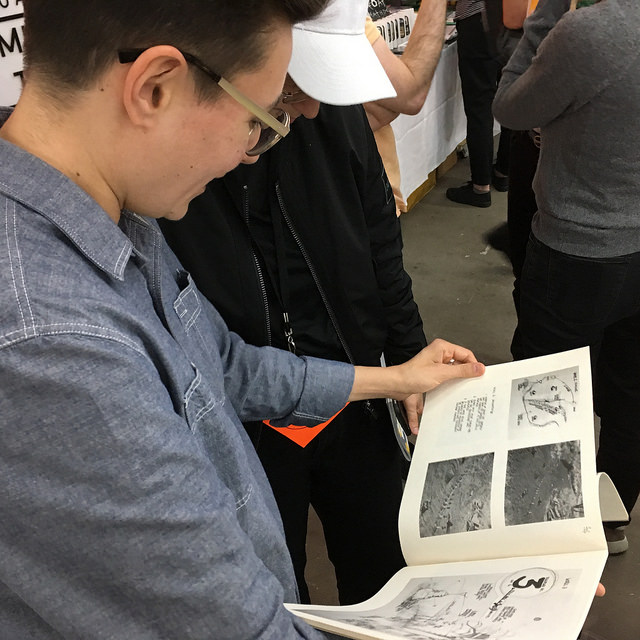
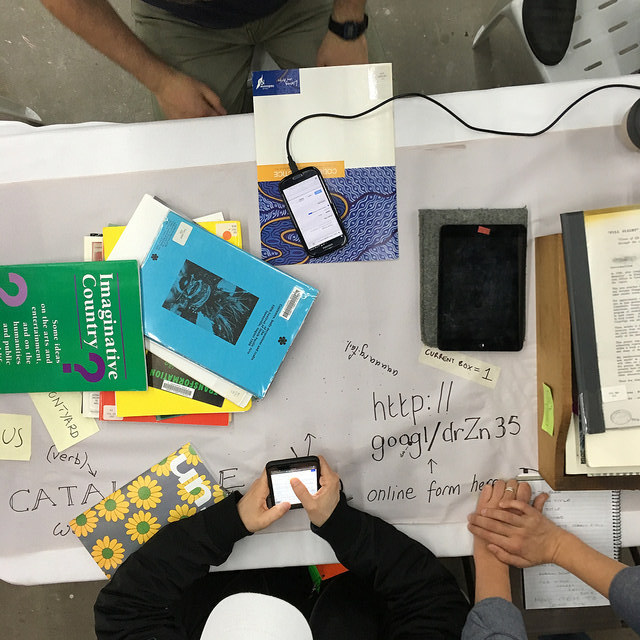
There were between one and five people cataloguing at any one time.
They would pick up an uncatalogued work from the western side of the table, and enter information about it into the form at http://goo.gl.drZn35 using their own phones or the iPad.
Between conversations, strolls through the fair, and reading, they catalogued over 200 works.
They welcomed passers by to join and had sometimes long conversations about the collection and its life at Frontyard. About a dozen people sat down and joined in.
They noted down some of what happened in the notebook:
Friday
Post-it note: The Australian Cultural Library “Steve Towson had 2hrs to collect as much of the Toowooba Public Library collection before it was demolished” / from Victoria Cooper GibB
Postcard: Cooper & Spowart wotwedid.com
SAT
Met a dancer who might like to develop a piece in residence — Luke 11:20
Met Lisa who is cataloging David Moore photo archive 10,000+ items — 11:40
Cataloging ‘Central Street’; Her Dad took photos for one of the included artists.
Steph from Inner West Council catalogued two items - 1pm
Kurt catalogued “+Positive: Artists Addressing Aids” 1:20pm
Had a chat with “not.Terry Reid” another stall holder who is involved with the slot project on Botany Rd @ Waterloo. - 1:41pm
Post-it note: From book: “[How the Irish saved the world] Monks in Ireland copied
outbooks that were being burned in Rome as a meditative practice” Fact from AVI - 3:41pm (btw 273-800 BCE)
Benjamin made a book of 100 cover photos taken in the cataloguing process as part of the VOLUME 2017 Book Machine:
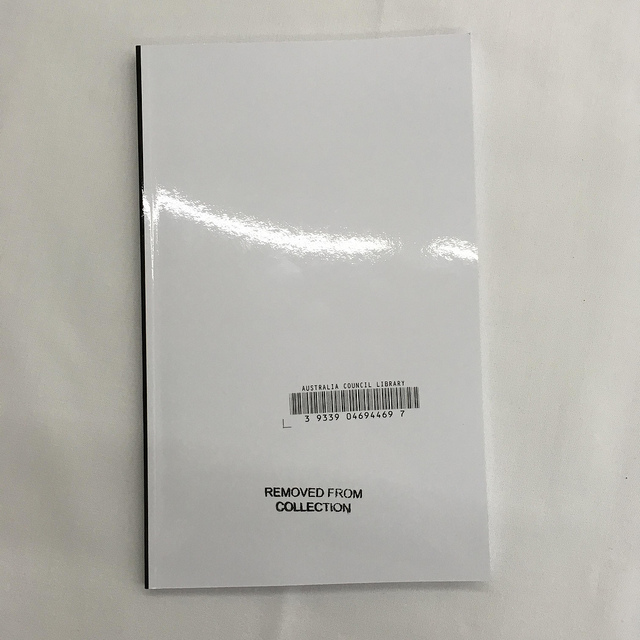
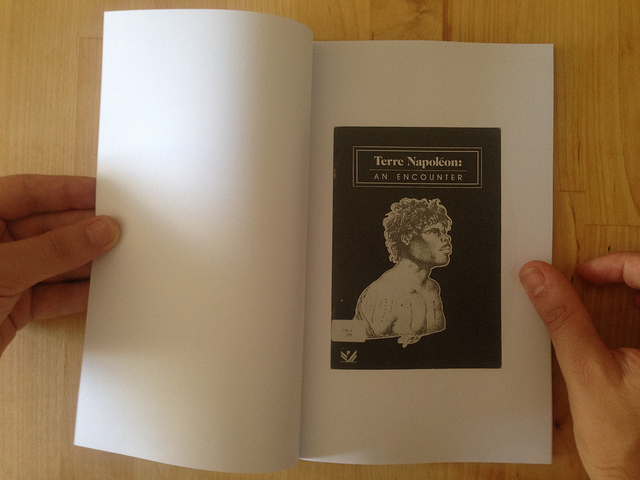
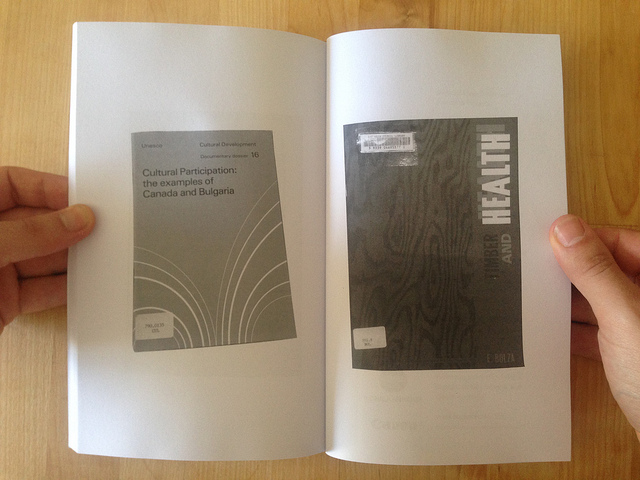
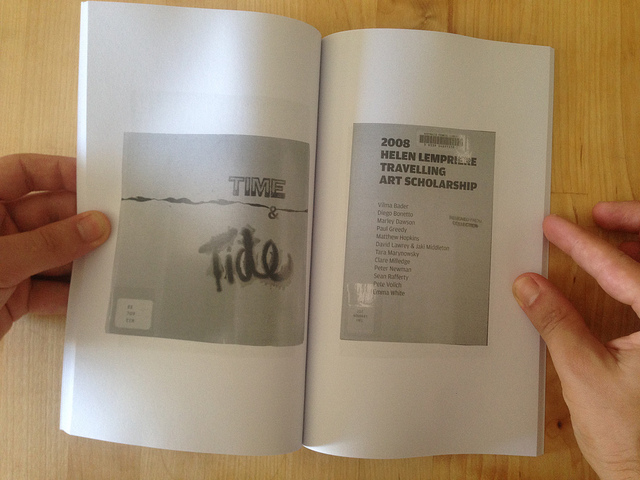
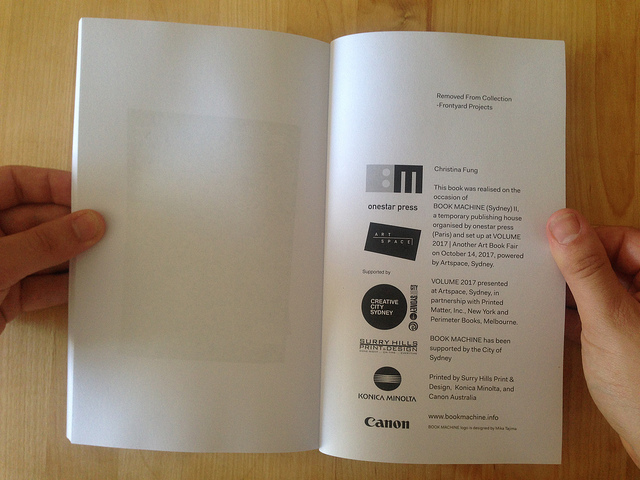
Julia made a book to provoke conversations for Frontyard’s speed book project at the 2017 Hobienalle.
I really enjoyed the excursion. It was nice to spend an intense weekend with the people who meet around Frontyard and people presenting at and attending the book fair. Highlights were the stalls from the Asia-Pacific Photobook Archive, Onomatopee, Lost Rocks, and Frontyard friend Nicky Minus.
What’s next
There are about 640 works waiting to be catalogued. If you’d like to help, sign up to the Frontyard Slack channel and let us know.
Our idea is that once the catalogue is complete, we’ll have the information we need to organise it and design some system through which it can be accessible reliably.
I think we need to do something with the growing catalogue to make it useful to people immediately and to incentivise the ongoing cataloguing. Maybe we should have a Frontyard residency to experiment and create something?
As we organise the library and design ways to present and access it, we need to think why the collection languished at the Australia Council. How can we avoid that happening again? How can we avoid re-creating the power structures that prevent people from living freely, critically, and creatively? I think input from people who’ve been part of the Decolonising Solidarity reading group at Frontyard could provide useful input to this project.